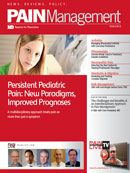Publication
Article
Pain Management
Clinicians Have Several Options for Treating Postherpetic Neuralgia
Author(s):
Specialists may differ on the nuances of treatment protocol when it comes to treating shingles (herpes zoster) and postherpetic neuralgia, but many agree on broad principles that can help primary care physicians diagnose and treat both conditions.
The distinctive rashes associated with shingles, extending along peripheral nerves, often on only one side of the body, usually facilitate easy diagnosis. But some experts say that shingles pain often precedes the appearance of visible rashes, and they advise physicians to familiarize themselves with the clinical characteristics of this condition in order to diagnose shingles based solely on risk factors and specific symptoms.
The major risk factors are: age (or some immunocompromising disease) and a history of chicken pox, which lurks forever in hosts, waiting to return as shingles. The telltale invisible symptom, the pain, generally radiates down nerve paths, just where rashes usually appear a few days later. “The key to minimizing shingles and preventing postherpetic neuralgia is to diagnose early and to treat both the virus and the pain very aggressively. An immunocompromised patient with shingles-like symptoms should be treated for shingles immediately. If you wait to see the rash and make a conclusive diagnosis, you’ll likely condemn your patient to far more shingles pain and a far greater chance of postherpetic neuralgia, which can mean years of severe discomfort,” says Dmitry M. Arbuck, MD, President of Meridian Health Group in Carmel, IN.
Treatment begins with antiviral medications such as valacyclovir. Arbuck advocates a course of treatment lasting anywhere from one to three weeks, with maintenance doses that can last for years for some patients. However, other physicians see no medical justification for prolonging treatment for more than the week of antiviral treatment recommended in standard guidelines (http://bit.ly/tcEuwh).
Treatment for pain frequently accompanies the antiviral medication. Patients with mild pain may need nothing more than acetaminophen. Many others, however, require complex regimens that may combine any or all of the following medications:
• tricyclic antidepressants like amitriptyline
• anticonvulsants like carbamazepine, gabapentin and lamotrigine
• topical analgesics like lidocaine patches or doxepin cream
• SNRIs, especially duloxetine
• pregabalin
• opioids
The importance of early diagnosis
The earlier physicians diagnose and treat shingles, the less likely patients are to suffer postherpetic neuralgia. Arbuck believes that doctors who treat shingles pain aggressively with anticonvulsants and antidepressants can usually prevent postherpetic neuralgia. Other clinicians say that nothing, even early diagnosis and aggressive treatment, will prevent many shingles cases from developing into postherpetic neuralgia.
As with shingles, the key to diagnosing postherpetic neuralgia is recognizing asymmetrical pain along nerve routes. “There’s no blood test. There’s no way to spot it on an MRI. The diagnosis comes from symptoms alone and they differ somewhat from patient to patient. Treatment also differs from patient to patient. Managing pain often requires complex combinations of medications. Family practitioners can and do treat this condition successfully by seeing patients frequently at first and adjusting the combination of medications until patients get relief. If severe pain continues for more than a month, patients should be sent to specialists,” says Shakil Ahmed, MD, Medical Director for the Division of Pain Medicine at Weill Cornell Medical College and Director of the Tri-Institutional Pain Fellowship Program.
There are several options for treating the pain associated with shingles and postherpetic neuralgia. Opioids like methadone are often prescribed more frequently for postherpetic neuralgia, which is generally more painful than the pain caused by shingles. Also, many physicians who use tricyclic antidepressants to treat shingles will use SNRIs like Cymbalta for postherpetic neuralgia. To help regenerate nerve tissue in patients with postherpetic neuralgia, some doctors use alternative treatments like Vitamins B6 and B12, folic acid, and Alpha-Lipoic acid.
Until very recently, there was no combination of drugs available on the market that could control the pain of some patients. But new medications, used in conjunction with older ones, have proven very effective. “It’s important that doctors learn how to use these new medications, which seem to make almost every case respond to treatment, but it’s even more vital that they learn the importance of administering the shingles vaccine. This tool can greatly reduce the incidence of a costly and painful disease, and it’s woefully underused. New treatments are great. Prevention is far better,” says Pradeep Chopra, MD, Director of the Interventional Pain Management Center of Rhode Island and Assistant Professor at Brown University Medical School.
